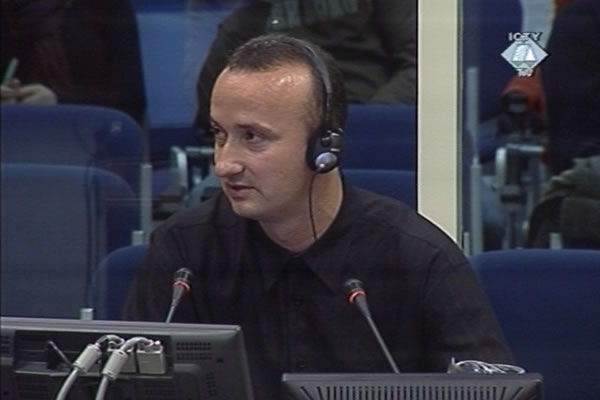Home
BUSES ON POTOCARI-KLADANJ ROUTE WERE ‘OVERBOOKED’
Former Bratunac Brigade military police officer is testifying at the Srebrenica Seven trial. On 12 and 13 July 1995, he was counting the Bosniaks who were transferred on buses and trucks to the territory under the BH Army control following the fall of Srebrenica
 Mile Janjic, witness in the trial of the former Bosnian Serb officials charged with crimes in Srebrenica
Mile Janjic, witness in the trial of the former Bosnian Serb officials charged with crimes in Srebrenica Mile Janjic, former VRS Bratunac Brigade military police officer, was ordered to go to Potocari with a few other colleagues on 12 July 1995 by security chief Momir Nikolic. They were to help count Bosniaks who were ‘evacuated’, on buses and trucks, to the territory controlled by the BH Army after the fall of Srebrenica. The indictment against seven Bosnian Serb military and police officers charged with crimes in Srebrenica and Zepa qualifies this ‘evacuation’ as the deportation or forcible transfer.
Janjic already testified before the Tribunal about what he did in Potocari in July 1995 as a defense witness of his former commander, Vidoje Blagojevic. In February 2007 he testified before the State Court in Sarajevo at the trial of four former colleagues, Bratunac brigade military police officers. After Janjic confirmed that he would give the same answers to the questions in court today, the transcript of his first testimony before the Tribunal was admitted into evidence at the Srebrenica Seven trial. In his brief examination-in chief, the prosecution wanted to clarify some parts of his evidence.
On 12 July 1995, the first day of the ‘evacuation’ from Potocari, Janjic and his colleagues boarded the vehicles and tried to count the people inside. Their records show that more than 9,000 persons were driven away on buses and trucks. According to Janjic, this number included men, who were separated from women and children and driven in the opposite direction, towards Bratunac. About 10 to 15 buses with the men left the area the first day, he estimated. On the second day, 13 July 1995, there were ‘surely twice or three times as many’. He explained that the Special Police forces separated the men from the rest of the population. This was not the ‘original’ or ‘honorable’ personnel, as he put it, but ‘the deserter formations’ attached to the Special Forces during the Srebrenica operation. One of his colleagues who escorted the Bosniak men told Janjic that they were taken to the school in Bratunac. Bratunac was close by and the buses could thus return to Potocari to pick up another batch of prisoners.
On the second day of the ‘evacuation’, when the ‘vehicles got overbooked’, as he said, and when Potocari ‘got terribly crowded’, Janjic suggested that they count the vehicles instead of persons, and then multiply this number by the average number of persons on board of buses and trucks. Their records from the previous day showed that the average number of persons on a bus was 70, and that 170 persons could fit into a big truck.
When they finished the job in Potocari and returned to Bratunac, Janjic and a few other members of his unit were sent to Rocevic on 14 or 15 July 1995. In front of the local school they met their commander Mirko Jovanovic and about 10 to 15 soldiers from the Bratunac Brigade. They told them that the school was full of Muslims and that they were waiting for the buses to arrive and take them to the territory controlled by the BH Army. After some time Janjic and the others were ordered to return to Bratunac, while the soldiers remained in front of the school.
The indictment alleges that about 500 Muslims held captive in the school in Rocevic were taken to the river Drina bank where they were shot to death.
As today’s hearing drew to a close, the defense counsel of the Srebrenica Seven started the cross-examination of Mile Janjic. It will continue tomorrow.
Linked Reports
- Case : Popovic et al. - "Srebrenica"
- 2007-11-09 BRITISH GENERAL’S ‘BIAS’
- 2007-11-08 BRITISH GENERAL IN ‘MLADIC’S SHOES’
- 2007-11-06 RUPERT SMITH: ‘BAD ASSESSMENT’ OF THE SREBRENICA SITUATION
- 2007-11-22 PROSECUTION WITNESSES GIVE CONTRADICTORY EVIDENCE
- 2007-11-28 DEFENSE: UNPROFOR WAS ‘CARELESS’ AND ‘BIASED’
- 2007-11-30 AIR SUPPORT CAME TO LATE FOR SREBRENICA
